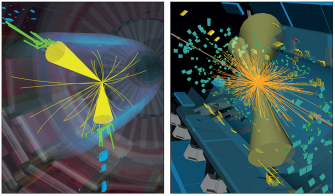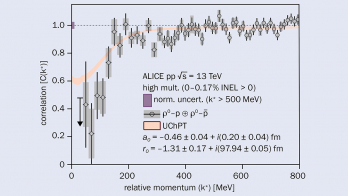A report from the ALICE experiment

When two lead nuclei collide in the LHC at an energy of a few TeV per nucleon, an extremely strong magnetic field of the order 1014 –1015 T is generated by the spectator protons, which pass by the collision zone without breaking apart in inelastic collisions. The strongest yet probed by scientists, this magnetic field, and in particular the rate at which it decays, is interesting to study since it probes unexplored properties of the quark–gluon plasma (QGP), such as its electric conductivity. In addition, chiral phenomena such as the chiral magnetic effect are expected to be induced by the strong fields. Left–right asymmetry in the production of negatively and positively charged particles relative to the collision reaction plane is one of the observables that is directly sensitive to electromagnetic fields. This asymmetry, called directed flow (v1), is sensitive to two main competing effects: the Lorentz force experienced by charged particles (quarks) propagating in the magnetic field, and the Faraday effect – the quark current that is induced by the rapidly decreasing magnetic field. Charm quarks are produced in the early stages of heavy-ion collisions and are therefore more strongly affected by the electromagnetic fields than lighter quarks.
An extremely strong magnetic field of the order 1014 –1015 T is generated
The ALICE collaboration has recently probed this effect by measuring the directed flow, v1, for charged hadrons and D0/D0 mesons as a function of pseudorapidity (η) in mid-central lead–lead collisions at √sNN = 5.02 TeV. Head-on (most central) collisions were excluded from the analyses because in those collisions there are very few spectator nucleons (almost all nucleons interact inelastically), which leads to a weaker magnetic field.

The top-left panel of the figure shows the η dependence of v1 for charged hadrons (centrality class 5–40%). The difference Δv1 between positively and negatively charged hadrons is shown in the bottom-left panel. The η slope is found to be dΔv1/dη = 1.68 ± 0.49 (stat) ± 0.41 (syst) × 10–4 – positive at 2.6σ significance. This measurement has a similar order of magnitude to recent model calculations of the expected effect for charged pions, but with the opposite sign.
The right-hand panels show the same analysis for the neutral charmed mesons D0 (cū) and D0 (c̄u) (centrality class 10–40%). The measured directed flows are found to be about three orders of magnitude larger than for the charged hadrons, reflecting the stronger fields experienced immediately after the collision when the charm quarks are created. The slopes, which are seen to be positive for D0 and negative for D0, are opposite and larger than in the model calculations. The slope of the differences in the directed flows is dΔv1/dη = 4.9 ± 1.7 (stat) ± 0.6 (syst) × 10–1 – positive at 2.7σ significance (lower-right panel). Also, in this case, the sign of the observed slope is opposite with respect to model calculations, suggesting that the relative contributions of the Lorentz and Faraday effects in those calculations are not correct.
Together with recent observations at RHIC, these LHC measurements provide an intriguing first sign of the effect of the large magnetic fields experienced in heavy-ion collisions on final-state particles. Measurements with larger data samples in Run 3 will have a precision sufficient to allow the contributions of the Lorentz force and the Faraday effect to be separated.
Further reading
ALICE Collaboration 2019 arXiv:1910.14406







